FUT Hair Transplant in India
FUT Hair Transplant is a hair reclamation method in India (Bella Soul India). It includes eliminating a piece of hair-bearing scalp, taking it apart into follicular units, and relocating them to thinning up-top regions.
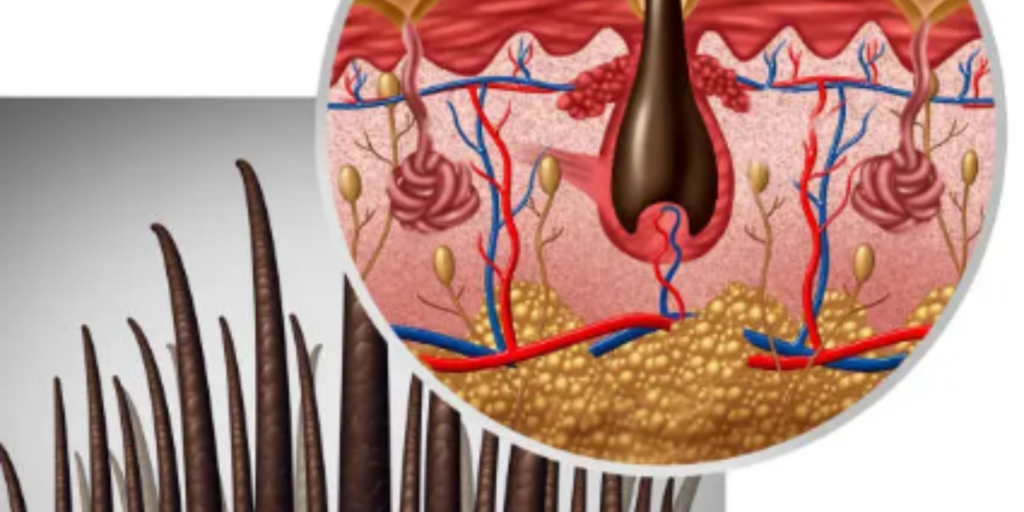
In this strategy, gifted specialists fastidiously analyse the strip into individual follicular units, each containing one to four hair follicles. These follicular units are then painstakingly relocated into the beneficiary regions on the scalp, where hair development is wanted.
The FUT method is known for its effectiveness in reaping an enormous number of unions in a solitary meeting, making it especially reasonable for people with broad balding. The interaction considers the exact situation of follicular units, guaranteeing a characteristic and stylishly satisfying outcome.
The progress of FUT hair transfers in India Clinics like Bella Soul India is credited to the ability of specialists, best-in-class offices, and headways in careful methods. Centre’s frequently give extensive counsel, assessing individual factors, for example, going bald example, benefactor hair thickness, and in general well-being to decide the office for the system.
Patients settling on FUT in India benefit from savvy arrangements without compromising the nature of care. The serious valuing incorporates different angles like interview, medical procedure, post-employable consideration, and follow-up arrangements.
While FUT enjoys its benefits, for example, a higher join endurance rate and cost-effectiveness, it’s fundamental for imminent patients to know about the possible downsides, including a straight scar at the contributor site. Propels in strategies like trichophytic conclusion plan to limit scarring, making FUT an undeniably great choice.
What is the FUT Hair Transplant Technique?
FUT, or Follicular Unit Transplant, is a hair recovery technique in India(Bella Soul India). It incorporates killing a piece of hair-bearing scalp, dismantling it into follicular units, and migrating them to diminishing up-top districts.
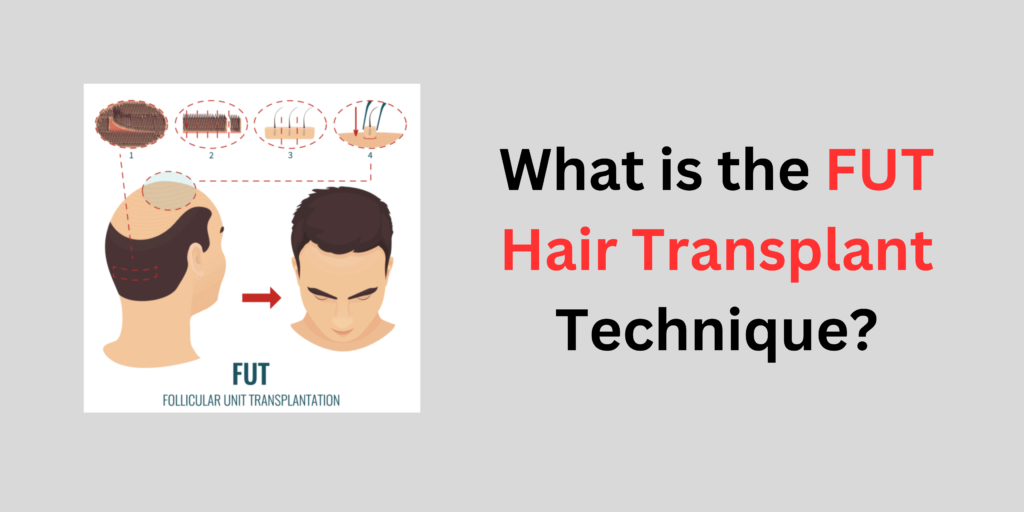
In this technique, gifted experts exactingly break down the strip into individual follicular units, each containing one to four hair follicles. These follicular units are then meticulously moved into the recipient districts on the scalp, where hair advancement is needed.
The FUT technique is known for its viability in procuring a gigantic number of associations in a single gathering, making it particularly sensible for individuals with expansive going bald. The communication thinks about the specific circumstances of follicular units, ensuring a trademark and beautifully fulfilling result.
The advancement of FUT hair moves in India is credited to the capacity of subject matter experts, top-tier workplaces, and degrees of progress in cautious strategies. Focuses often give broad direction, surveying individual variables, for instance, going bare model, promoter hair thickness, and everyday prosperity to choose the workplace for the framework.
Patients choosing FUT in India benefit from canny game plans without compromising the idea of care. The serious esteeming integrates various points like meeting, operation, post-employable thought, and follow-up game plans.
While FUT partakes in its advantages, for instance, a higher join perseverance rate and cost-viability, it’s basic for impending patients to be familiar with the potential drawbacks, including a straight scar at the donor site. Pushes in techniques like trichophytic end intend to restrict scarring, settling on FUT a certainly extraordinary decision.
What is the FUT Hair Transplant Procedure?
FUT includes reaping a portion of the giver’s scalp, removing hair follicles, and embedding them in bare regions. This strategy guarantees normal hair development designs. The FUT (Follicular Unit Relocate) hair relocate method is a surgery intended to address going bald and advance hair regrowth. This technique includes a few key stages:
- Giver Strip Gathering: A portion of the hair-bearing scalp is carefully taken out from the benefactor region, normally situated at the back or sides of the head. This region is picked for its protection from thinning up top.
- Benefactor Strip Analyzation: The gathered strip is then painstakingly analyzed under a magnifying instrument by talented specialists. This microdissection isolates the strip into individual follicular units, which are little groupings of hair follicles.
- Beneficiary Site Arrangement: When the follicular units are prepared, the beneficiary locales on the going bald or diminishing region of the scalp are ready. Specialists make little cuts where the new hair follicles will be embedded.
- Follicular Unit Implantation: The took-apart follicular units are decisively positioned into the beneficiary destinations. This interaction expects accuracy to guarantee the normal development example and stylish appearance of the relocated hair.
- Conclusion of Contributor Region: After the follicles are embedded, the benefactor region is shut utilizing stitches or staples. The conclusion strategy might include progressed techniques like the trichophytic conclusion to limit scarring.
The FUT strategy is famous for its capacity to reap countless unions in a solitary meeting, making it reasonable for people with critical balding. The utilization of follicular units takes into consideration a more normal-looking outcome, as the relocated hair mirrors the regular development design.
Notwithstanding its viability, FUT has an unmistakable trademark – it leaves a direct scar at the benefactor site. Notwithstanding, headways in conclusion procedures mean to make this scar less obvious, giving better tasteful results.
What is the procedure of the FUT Technique?
A scalpel is removed, the wound is closed, and the scalpel is divided into separate follicular units by the surgeon. The recipient areas on the scalp are then carefully transplanted with these units.
To address hair loss and restore natural hair growth, a surgical method known as FUT (Follicular Unit Transplantation) is used step-by-step. There are multiple crucial phases in the process:
- Preoperative Planning
- Donor Area Identification
- Local Anesthesia Administration
- Donor Strip Harvesting
- Donor Strip Dissection
- Recipient Site Preparation
- Follicular Unit Implantation
- Closure of Donor Area
The technique of the FUT procedure in detail
The FUT (Follicular Unit Transplant) methodology is a fastidious and unpredictable careful procedure aimed toward reestablishing hair development in people encountering balding. Here is an itemized outline of the key advances engaged with the FUT methodology:
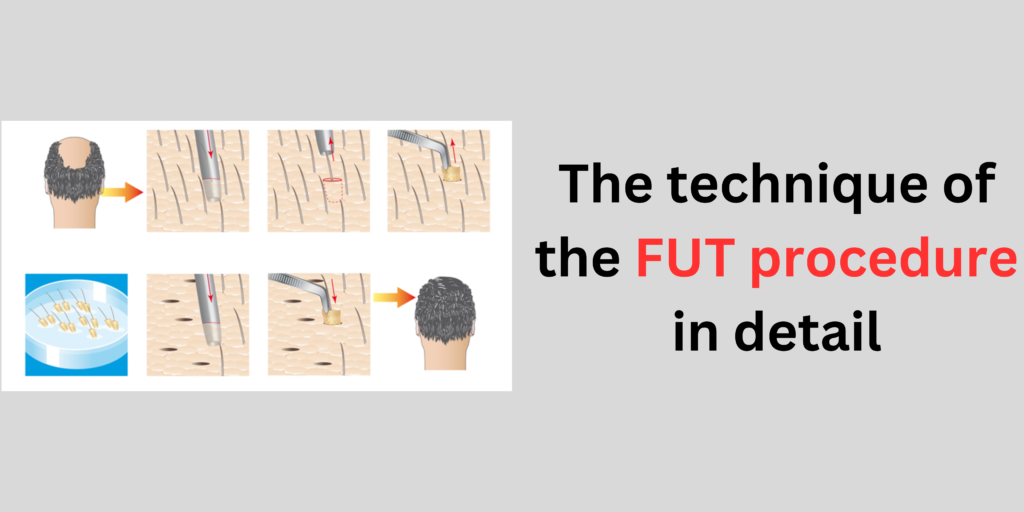
Preoperative Preparation:
- A complete discussion with the specialist surveys the patient’s particular going bald example, assumptions, and general well-being.
- The specialist teams up with the patient to decide the ideal hairline, thickness, and stylish objectives.
Benefactor Region Recognizable proof:
- The specialist distinguishes the giver region, typically at the back or sides of the scalp, where hair follicles are hereditarily impervious to going bald.
- The picked region guarantees the collected hair will keep up with its flexibility against additional balding.
Neighborhood Sedation Organization:
- Neighborhood sedation is controlled by the contributor and beneficiary regions to guarantee the patient’s remaining parts are agreeable and torment-free during the methodology.
Contributor Strip Collecting:
- An exact segment of the hair-bearing scalp is carefully eliminated from the contributor region. The elements of the strip are painstakingly intended to amplify united yield while limiting scarring.
- The entry point is shut utilizing methods like the trichophytic conclusion to decrease the permeability of the direct scar.
Benefactor Strip Analyzation:
- The gathered strip is given over to a group of exceptionally gifted professionals. Under a magnifying lens, they carefully analyze the strip into individual follicular units.
Beneficiary Site Creation:
- Minuscule cuts, known as beneficiary destinations, are made in the beneficiary region where hair development is wanted. The specialist thinks about the normal hairline, thickness, and stylish equilibrium during this interaction.
Follicular Unit Implantation:
- The specialist cautiously embeds the analyzed follicular units into the beneficiary destinations. The objective is to mirror the normal hair development design, guaranteeing a characteristic and tastefully satisfying outcome.
- The point, profundity, and dividing of the inserts are critical for accomplishing consistent incorporation with existing hair.
Conclusion of Benefactor Region:
- The benefactor region is shut utilizing stitches or staples, with accuracy to limit scarring. High-level conclusion methods, such as a trichophytic conclusion, include covering the edges to decrease the permeability of the scar.
Postoperative Consideration:
- Patients get definite postoperative consideration directions, remembering data for prescription, cleanliness, and exercises to stay away from during the underlying recuperation time frame.
- Customary subsequent arrangements permit the specialist to screen progress, address concerns, and guarantee ideal recuperation.
Good Candidate for FUT Hair Transplant
Choosing an optimal possibility for FUT (Follicular Unit Transplant) includes an exhaustive assessment of different elements to guarantee the progress of the method and good results. Here are the qualities of a decent contender for FUT hair Transplant:

- Satisfactory Giver Hair: An ideal competitor ought to have an adequate measure of benefactor’s hair toward the back or sides of the scalp. This region fills in as the hotspot for follicles impervious to thinning up top, guaranteeing fruitful transplantation.
- Stable Going bald Example: Competitors with a steady example of going bald are ideal. Unsurprising going bald permits specialists to decisively design the transfer, taking into account both current and expected future thinning up top regions.
- Practical Assumptions: A decent competitor grasps the sensible results of the FUT technique. While it reestablishes hair, it’s fundamental for people to have sensible assumptions about the degree of inclusion and the time expected for apparent outcomes.
- By and large Wellbeing: Great general wellbeing is pivotal for an effective FUT methodology. Competitors ought to be liberated from ailments that might confuse a medical procedure or ruin the mending system.
- No Dynamic Scalp Diseases: Up-and-comers shouldn’t have any dynamic contaminations or skin conditions on the scalp. A sound scalp guarantees a reasonable climate for united endurance and limits the gamble of difficulties.
- Obligation to Aftercare: Effective FUT results rely upon adherence to postoperative consideration guidelines. A decent up-and-comer is willing and ready to follow the specialist’s proposals for legitimate cleanliness, prescription, and way of life changes during the recuperation time frame.
Cost of FUT Hair Transplant
The expense of FUT shifts as per the center, the experience of the doctor, and the region. Costs, all things considered, incorporate interview, medical procedure, recuperation care, and follow-up visits. In India, prices can vary from thousands to lakhs of rupees.
- Side effects of FUT Hair Transplant: While FUT (Follicular Unit Transplant) is a for the most part protected and powerful hair reclamation strategy, similar to any careful mediation, it very well might be related to specific secondary effects. Understanding these potential incidental effects is significant for people thinking about FUT. Here are normal incidental effects:
- Enlarging and Swelling: Enlarging and swelling around the temple and eyes are normal in the underlying days after FUT. These are transitory and continuously die down as the mending system advances.
- Uneasiness and Agony: Gentle uneasiness and agony at the contributor and beneficiary locales are typical postoperative encounters. Drugs endorsed by the specialist assist with dealing with any related aggravation during the recuperation time frame.
- Deadness or Shivering: A few patients might encounter transitory deadness or shivering in the contributor and beneficiary regions. This commonly settles as the nerves recover.
- Tingling: Tingling on the scalp is a typical incidental effect during the mending system. Patients are prompted not to scratch the treated regions to try not to disturb units.
- Contamination: Albeit intriguing, the disease is a possible secondary effect. Severe adherence to postoperative consideration guidelines, including legitimate cleanliness and drug, limits the gamble of contamination.
- Scarring: FUT leaves a straight scar at the contributor site, which is an intrinsic part of the system. While progressions in conclusion procedures mean to limit scarring, the presence of a scar is a typical secondary effect that differs in permeability.
- Shock Misfortune: Some current hair close to the beneficiary destinations might go through transitory shedding, known as shock misfortune. This is an ordinary piece of the mending system, and new hair development will supplant the lost hair over the long run.
- Growths: Little growths might be created at the beneficiary locales. These are for the most part harmless and can be treated by the specialist if vital.
Precautions for FUT Hair Transplant
Following FUT (Follicular Unit Transplant) hair Transplant a medical procedure, playing it safe is fundamental for a smooth recuperation and ideal outcomes. Here are significant safety measures to consider:
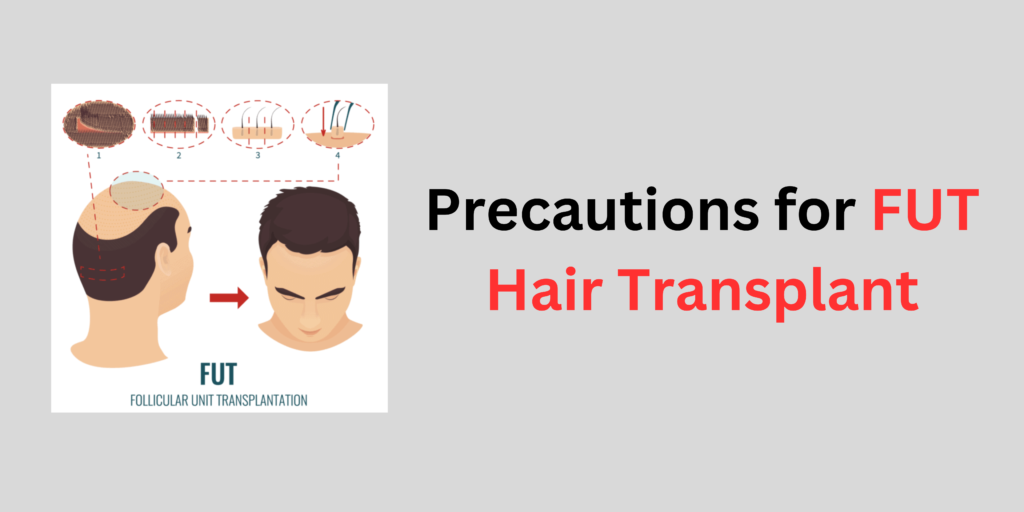
- Keep away from Demanding Exercises: Shun participates in difficult exercises, hard work, or extraordinary activities for a predetermined period after the medical procedure. This forestalls pointless stress on the giver and beneficiary regions.
- Safeguard the Scalp: Safeguard the scalp from direct daylight and ecological components. Wearing a cap or utilizing sunscreen is essential, particularly during the underlying week’s post-medical procedure when the scalp is more defenseless.
- Adhere to Prescription Guidelines: Stick rigorously to the endorsed drugs, including anti-microbial and painkillers. These meds help in forestalling disease, overseeing torment, and advancing sound recuperation.
- Stay away from Liquor and Smoking: Cease from polishing off liquor and try not to smoke during the recuperation time frame. Both can ruin the recuperating system and increment the gamble of difficulties.
- Delicate Hair Washing: Adhere to the specialist’s rules for hair washing. Utilize a gentle, suggested cleanser and be delicate while cleaning the scalp to try not to unstick.
- Abstain from Contacting or Scratching: Oppose the impulse to contact, scratch, or pick at the contributor or beneficiary regions. This forestalls contamination and guarantees the soundness of recently relocated units.
- Dozing Position: Lay down with your head raised during the underlying days after a medical procedure. This limits enlarging and elevates appropriate blood flow to the scalp.
- Limit Sun Openness: Limit direct sun openness to the scalp, particularly during the initial not many weeks. Sunscreen or a cap gives insurance and forestalls expected difficulties.
Patients ought to adhere to post-employable consideration directions, keeping away from arduous exercises and safeguarding the scalp. Legitimate cleanliness and prescription adherence limit disease risk, guaranteeing ideal recuperation.
Advantages of FUT Hair Transplant
FUT (Follicular Unit Transplant) hair Transplant enjoys a few benefits that make it a favored decision for some people looking for hair reclamation. Here are the key benefits of the FUT strategy:
- High Join Yield: FUT considers the gathering of countless unions in a solitary meeting. This is especially helpful for people with broad balding, giving more than adequate follicles to transplantation.
- Savvy: FUT is in many cases more financially savvy contrasted with other hair relocation strategies. The capacity to get an enormous number of unions in a single meeting adds to the expense proficiency of the technique.
- Proficient for Broad Balding: Appropriate for people with cutting-edge phases of going bald, FUT effectively covers bigger bare regions in a solitary strategy. This makes it a powerful answer for those requiring broad inclusion.
- Speedier Methodology: FUT systems commonly take less time contrasted with other hair Transplant strategies. The proficient reaping and transplantation of follicular units add to a speedier general cycle.
- Higher Join Endurance Rate: The unions that got through FUT frequently have a higher endurance rate because of their fastidious care during the analysis cycle. This improves the probability of effective hair development in the relocated regions.
- Direct Scar Handily Hid: While FUT leaves a direct scar at the giver site, it tends to be handily hidden by encompassing hair. For the people who favor longer haircuts, the scar is commonly not observable.
- Decreased Follicle Exchange: FUT includes eliminating a piece of the scalp for reaping and decreasing the gamble of follicle exchange (harm to hair follicles). This helps save the respectability of the relocated follicles.
- Appropriate for Explicit Hair Types: FUT is in many cases appropriate for people with specific hair types, like wavy or coarse hair. The strategy takes into account the exact position of follicular units, upgrading the normal appearance of the relocated hair.
Limitation of FUT Hair Transplant Procedure
FUT leaves a direct scar, influencing short haircuts. Recuperation time is longer contrasted with FUE. Be that as it may, headways like trichophytic conclusion expect to limit scarring.
- Noticeable Direct Scar: FUT leaves a recognizable direct scar at the benefactor site, which might restrict hairdo decisions for people who are inclined toward more limited hairstyles.
- Longer Recuperation Time: Recuperation after FUT is ordinarily longer contrasted with some other hair Transplant strategies, requiring cautious adherence to postoperative consideration.
- Potential for Postoperative Uneasiness: A few patients might encounter gentle postoperative uneasiness, enlarging, or deadness, which is regularly impermanent but requires persistence during the recuperation interaction.
- Hazard of Contamination: Albeit interesting, there is a likely gamble of disease, underlining the significance of adhering to postoperative consideration directions for legitimate cleanliness.
- Restricted Unite Collecting in the Future: Since FUT includes eliminating a portion of the scalp, there is a limited measure of benefactor hair accessible. This might restrict the capacity to go through extra FUT strategies later on.
- Higher Probability of Crosscut: The strategy for strip reaping in FUT might have a higher gamble of follicle crosscut (harm to hair follicles) contrasted with specific other Hair Transplant procedures.
- Not Great for Specific Hair Types: FUT might be not so great for people with exceptionally close or wavy hair as the straight scar can be more recognizable in these cases.
- More Obtrusive Procedure: FUT is viewed as a more obtrusive methodology because of the strip evacuation, requiring cautious thought for people with explicit well-being concerns.
- Shock Misfortune Potential: Some current hair close to the beneficiary destinations might go through transitory shedding (shock misfortune) during the recuperating system, influencing the general appearance briefly.
- Individual Fluctuation in Scarring: The permeability of the straight scar can differ between people in view of variables like skin type, ability to recuperate, and adherence to postoperative considerations.
Two Different Hair Transplant Techniques
There are two unique methods for hair transplantation: follicular unit transplantation (FUT) leaves tiny, dispersed scars that resemble tiny dots since it removes individual hair follicles from the donor area directly with a punch instrument and implants them into the recipient area. For individuals who want the least amount of scarring, FUE is the method of choice because it is less intrusive and requires a speedier recovery.

Difference between FUT & FUE Hair Transplant:
| Feature | Follicular Unit Transplant (FUT) Hair Transplant | Follicular Unit Extraction (FUE) Hair Transplant |
| Harvesting Technique | Strip harvesting: A linear strip of the scalp is removed. | Individual follicles are extracted one by one. |
| Scarring | Linear scar at the donor site, typically easily hidden. | Tiny, scattered dot-like scars, less noticeable. |
| Recovery Time | Longer recovery time due to the linear incision. | Shorter recovery time, less postoperative discomfort. |
| Pain and Discomfort | Potential for more discomfort due to the strip removal. | Generally less pain and discomfort, minimally invasive. |
| Graft Yield | Higher graft yield per session, suitable for extensive hair loss. | Lower graft yield per session may require multiple sessions. |
| Donor Area Appearance | Linear scars may limit hairstyle choices. | Less noticeable scars, suitable for shorter hairstyles. |
| Ideal Candidates | Those with ample donor hair and extensive hair loss. | Those with limited donor hair and smaller areas to cover. |
| Procedure Duration | Quicker procedure due to simultaneous graft harvesting. | Takes longer due to individual extraction of follicles. |
| Risk of Follicle Damage | Slightly higher risk of follicle transection during strip removal. | Lower risk of follicle damage due to individual extraction. |
| Cost | Generally more cost-effective per graft. | May be more expensive per graft due to longer procedures. |
| Suitability for Certain Hair Types | Suitable for various hair types. | May be less suitable for very tight or curly hair types. |
| Number of Sessions | May require fewer sessions for extensive coverage. | May require multiple sessions for larger areas. |
FUT vs FUE Pros and Cons
FUT (Follicular Unit Transplant):
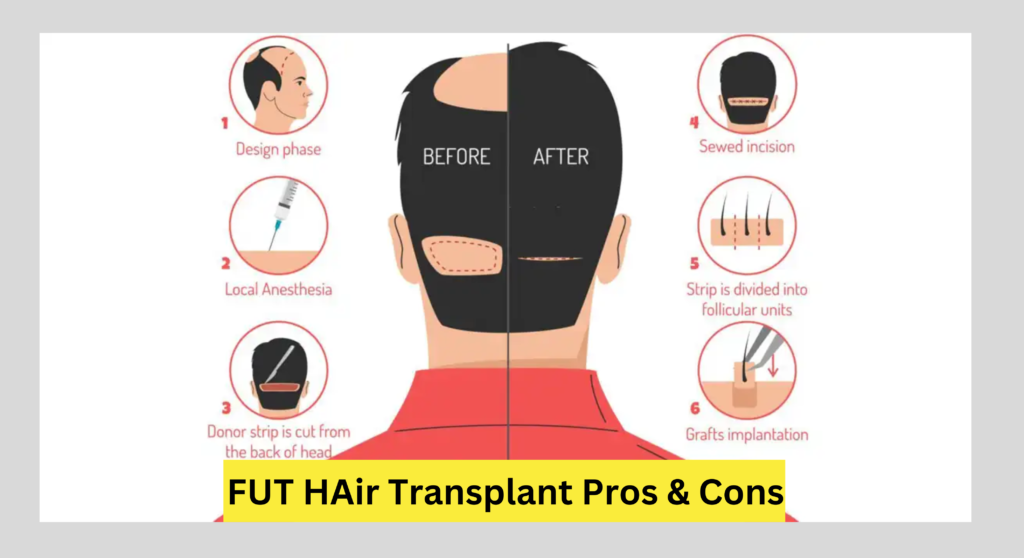
Pros:
- Higher graft yield per session, suitable for extensive hair loss.
- Quicker procedure due to simultaneous graft harvesting.
- Generally more cost-effective per graft.
- Ideal for individuals with ample donor hair and extensive hair loss.
- Suitable for various hair types.
- Donor grafts are harvested efficiently in a single session.
Cons:
- Linear scar at the donor site, which may limit hairstyle choices.
- Longer recovery time due to the linear incision.
- Potential for more discomfort due to the strip removal.
- Higher risk of follicle transection during strip removal.
- Donor area appearance may be a concern for those with shorter hairstyles.
FUE (Follicular Unit Extraction):
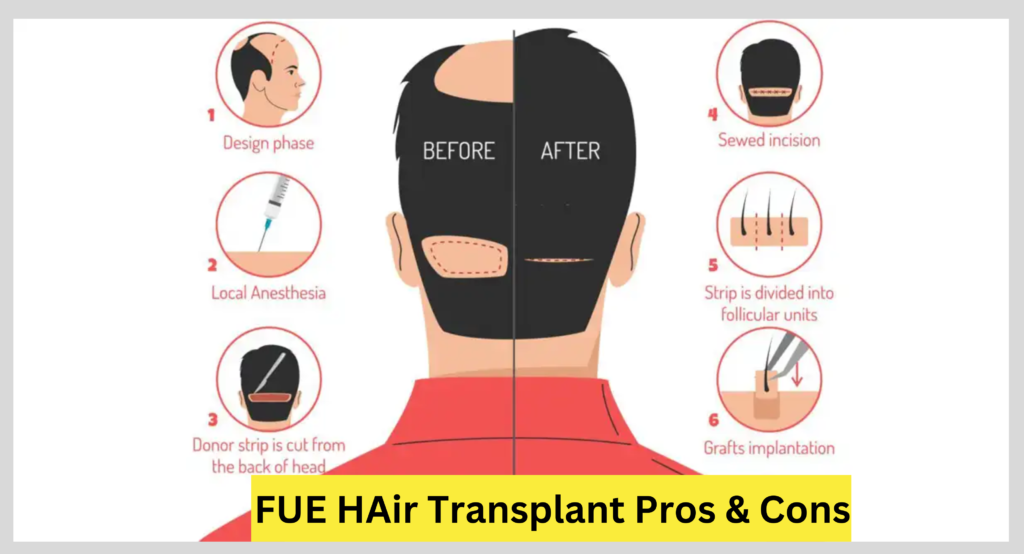
Pros:
- Minimal scarring with tiny dot-like scars.
- Shorter recovery time and less postoperative discomfort.
- Generally, less pain and discomfort, are considered minimally invasive.
- Suitable for smaller areas, allowing targeted placement.
- Less noticeable scars, making it suitable for shorter hairstyles.
- Ideal for individuals with limited donor hair and smaller areas to cover.
- The procedure duration may be longer due to individual extraction.
Cons:
- May be more expensive per graft due to the longer procedure.
- Lower graft yield per session, suitable for smaller areas.
- Risk of overharvesting if not performed by an experienced surgeon.
Which Technique is Good FUE or FUT?
It’s reasonable for people with restricted balding or individuals who lean toward more modest, designated medicines. Nonetheless, FUE might be costlier per unit and could yield fewer joins in a solitary meeting.
Then again, FUT is a favored decision for people with broad going bald requiring huge inclusion. It offers a higher join yield for every meeting, making it a financially savvy choice. Notwithstanding, FUT includes a straight scar at the benefactor site, possibly restricting hairdo decisions, and has a more drawn-out recuperation time.
Eventually, the choice relies upon factors like the degree of balding, financial plan contemplations, wanted haircuts, and individual inclinations. Talking with a certified hair Transplant specialist is urgent, as they can survey individual necessities and give custom-fitted proposals to accomplish the most ideal outcomes. Every procedure has its upsides and downsides, and the decision ought to line up with the patient’s particular conditions and objectives.
Why FUT is Best for Hair Transplant Procedure
FUT (Follicular Unit Transplant) is viewed as best for specific hair transplant situations because of its benefits. FUT considers the collecting of a bigger number of unions in a solitary meeting, making it a practical choice for people with broad going bald. The strategy gives proficient inclusion of huge bare regions and yields a high join endurance rate. Regardless of leaving a direct scar at the giver site, headways in conclusion procedures limit its permeability. FUT is reasonable for individuals who wouldn’t fret about a direct scar and are searching for an extensive arrangement with a possibly faster methodology. Furthermore, people with adequate contributor hair and an inclination for longer hairdos might view FUT as a positive decision. FUT succeeds in yielding an enormous number of unions in a solitary meeting, making it reasonable for broad going bald. Its expense adequacy requests to numerous patients looking for ideal outcomes.
Expected Recovery Time for FUT
The expected recovery time for FUT (Follicular Unit Transplant) involves several stages:
- Immediate Post-Op (Days 1-2):
- Patients may experience swelling, discomfort, and tightness in the donor area.
- Bandages are typically removed after a day or two.
- First Week:
- Rest and avoid strenuous activities.
- Return to non-strenuous work within a week.
- Swelling and redness begin to subside.
- First Two Weeks:
- Gentle hair washing and sun protection are crucial.
- Scabbing in the recipient area starts to fall off.
- First Month:
- Some temporary shedding of transplanted hair (shock loss) may occur.
- Donor site scar heals, and residual scabbing disappears.
- First Three Months:
- Initial signs of new hair growth become noticeable.
- The majority of swelling and redness resolves.
- First Six Months to One Year:
- Continued hair growth occurs, and transplanted hair becomes more visible.
- Final results, including improved density, are typically evident within one year.
Conclusion
FUT is a good alternative for hair restoration because it’s affordable and has a high graft yield. The decision between FUT and FUE is influenced by personal preferences, financial constraints, and intended results.
FAQs About FUT Hair Transplant
Indeed, patients can cautiously mix FUT and FUE, utilizing every strategy’s benefits to obtain the most ideal results.
The length of the system shifts, yet frequently ranges from a couple of hours to an entire day, depending upon the level of going bald and the picked strategy.
Yes, scarring occurs in both FUT and FUE. FUT results in a linear scar, while FUE leaves tiny, scattered scars. Advances aim to minimize scarring for both techniques.
